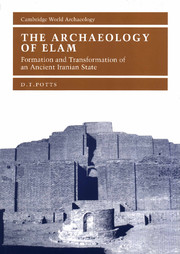Book contents
- Frontmatter
- Contents
- List of illustrations
- List of plates
- List of tables
- Preface and acknowledgements
- List of abbreviations
- Note on transliteration and dating systems
- 1 Elam: what, when, where?
- 2 Environment, climate and resources
- 3 The immediate precursors of Elam
- 4 Elam and Awan
- 5 The dynasty of Shimashki
- 6 The grand regents of Elam and Susa
- 7 The kingdom of Susa and Anshan
- 8 The Neo-Elamite period
- 9 Elam in the Achaemenid empire
- 10 Elymais
- 11 Elam under the Sasanians and beyond
- 12 Conclusion
- References
- Index
11 - Elam under the Sasanians and beyond
Published online by Cambridge University Press: 22 September 2009
- Frontmatter
- Contents
- List of illustrations
- List of plates
- List of tables
- Preface and acknowledgements
- List of abbreviations
- Note on transliteration and dating systems
- 1 Elam: what, when, where?
- 2 Environment, climate and resources
- 3 The immediate precursors of Elam
- 4 Elam and Awan
- 5 The dynasty of Shimashki
- 6 The grand regents of Elam and Susa
- 7 The kingdom of Susa and Anshan
- 8 The Neo-Elamite period
- 9 Elam in the Achaemenid empire
- 10 Elymais
- 11 Elam under the Sasanians and beyond
- 12 Conclusion
- References
- Index
Summary
The Parthian empire was brought down by Ardashir, a native of Istakhr in Fars who successfully overthrew Artabanus IV, last of the Parthian kings, in AD 224, and thereby laid the foundations for what has become known as the Sasanian empire. There is no shortage of important archaeological sites in Fars and Khuzistan dating to the Sasanian period (AD 224–642), such as Susa, Gundeshapur and Ivan-e Kerkha. But where are the Elamites? By the Sasanian period it is difficult to discern elements of distinctive Elamite identity in southwestern Iran, although there are some indications that the Elamite language survived in places. After the Islamic conquest, however, we see the name ‘Elam’ used to identify the ecclesiastical province of the Nestorian church, a major branch of Christianity widespread in the Sasanian empire, located in Khuzistan. Sources dating to between the eighth and fourteenth centuries AD make frequent reference to the Nestorian ecclesiastical province of Elam which seems to have eventually succumbed to conquest by Tamerlane in about AD 1400. In this case the revival of the name Elam can be attributed to religious usage.
Introduction
As we have seen, the political status of Elymais in the late Parthian period is difficult to characterize on the basis of the very scarce data available to us today.
- Type
- Chapter
- Information
- The Archaeology of ElamFormation and Transformation of an Ancient Iranian State, pp. 410 - 433Publisher: Cambridge University PressPrint publication year: 1999

